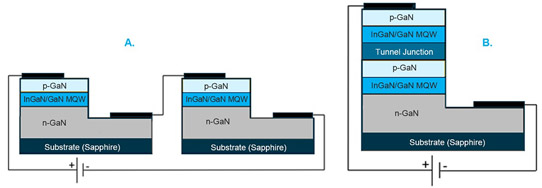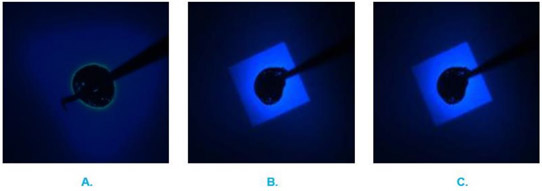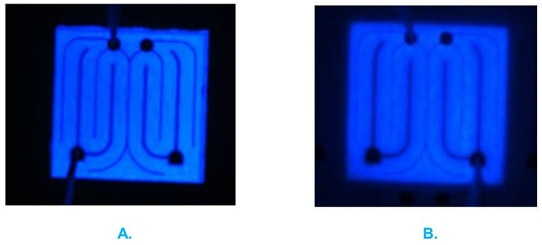- News
4 January 2019
BluGlass demonstrates functioning tunnel junctions, enabling cascaded LEDs
BluGlass Ltd of Silverwater, Australia – which was spun off from the III-nitride department of Macquarie University in 2005 – says that, using its low-temperature remote-plasma chemical vapour deposition (RPCVD) manufacturing technique for its unique as-grown and activated p-GaN (AAG) technology, it has demonstrated functioning tunnel junctions to enable the fabrication of cascaded light-emitting diodes.
Cascaded LEDs can mitigate the efficiency droop seen in gallium nitride (GaN)-based LEDs, where light output efficiency drops as the driving current increases. For many applications (particularly lighting) LEDs are typically driven at high current to generate the maximum brightness - significantly higher than the point where the efficiency begins to drop, so devices are operating outside their peak efficiency range.
A simple solution is to replace a single LED with multiple LED chips, in which case the desired amount of light can be generated by driving each LED at a lower current that is matched to the individual chip’s peak efficiency. However, this increases cost and the required real-estate.
A better solution is to use a single chip to grow LEDs in a continuous vertical stack using a tunnel junction to interconnect the multiple LEDs on a single chip. Such a vertically arranged multi-junction, cascaded LED benefits from reduced efficiency droop as emitted light power is increased by stacking voltage, rather than current, without increasing the required device real-estate (hence increasing the emitted light power density). For example, cascaded LEDs could be used in automotive headlights, where there are strict limitations on the lateral size of the devices, to achieve optimal performance. The vertical solution also increases the number of devices than can be made from a single wafer, reducing manufacturing costs.

Figure 1: The different structure and physical arrangement between two laterally spaced and interconnected LEDs (A) versus a single vertical cascaded LED using a tunnel junction (B).
Tunnel junctions are used in other semiconductor applications such as solar cells, but there are currently no GaN-based commercial products on the market that utilize them and hence, to date, cascaded LEDs have not been commercially available. This is because achieving working tunnel junctions in the GaN-based material system has proven very difficult to achieve using incumbent metal-organic chemical vapour deposition (MOCVD) manufacturing technology since the nitrogen source is ammonia (toxic and expensive), which requires high growth temperatures and results in significant quantities of hydrogen being incorporated in the epitaxial layers.
In contrast, BluGlass’ RPCVD technology includes low-temperature deposition coupled with nitrogen plasma as the nitrogen source rather than ammonia (yielding little incorporated hydrogen), enabling the fabrication of practical GaN-based tunnel junction devices.

Figure 2: Bare wafer comparison. Optical micrographs of light distribution of non-processed LED wafers (characterized on wafer using BLG electroluminescence quick test, using indium dot contacts): (a) commercial MOCVD full blue LED without indium tin oxide (ITO), (b) commercial MOCVD full blue LED with indium tin oxide (ITO), and (c) RPCVD tunnel-junction overgrowth on commercial MOCVD partial blue LED without ITO.
A key feature is the ability to achieve the required buried activated p-type gallium nitride (p-GaN) – critical for the function of the tunnel junction – without the need for the complicated and time-consuming ex-situ lateral activation methods employed by MOCVD. This unique ‘as-grown and activated p-GaN’ (AAG) technology for enabling a buried p-GaN layer to remain activated in various devices is a fundamental advantage of using RPCVD, says the firm.
BluGlass has been developing its tunnel-junction capabilities for several years, initially for triple-junction InGaN solar cells. The firm is now optimizing the RPCVD tunnel junctions for realizing cascaded LEDs with the performance required to address the stringent requirements of both brightness and small form factor for existing and emerging LED markets.

Figure 3: Fully processed wafer comparison. Optical micrographs of fully processed LED light distribution of (a) commercial MOCVD full blue LED with ITO and (b) RPCVD tunnel-junction overgrown on a commercial MOCVD partial blue LED without ITO.
BluGlass claims that RPCVD-grown tunnel junctions could be commercially compelling for applications including not just high-performance LEDs (for automotive lighting) and high-efficiency multi-junction solar cells but also ultraviolet LEDs (for water purification) and high-power laser diodes (for industrial machining applications).
Chief operations & technology officer Dr Ian Mann is presenting a talk on RPCVD-grown tunnel junctions for cascaded LEDs at the Photonics West 2019 conference in San Francisco, CA, USA (2-7 February).
Facilities update
BluGlass’s facility upgrade is approaching completion. The firm has taken delivery of an Aixtron AIX 2800 G4 commercial-scale MOCVD platform, to be retrofitted with RPCVD. A second system is arriving in January.
The upgrade will provide BluGlass with extra capacity for industry collaborations to demonstrate the key benefits of RPCVD platform technology for tunnel-junction-enabled cascaded LEDs, micro-LEDs and power electronics, among other applications.
Lumileds collaboration update
Further to its recent disclosure at its annual general meeting (AGM) on 19 November, BluGlass says that it remains in negotiations with LED maker Lumileds of San Jose, CA, USA to extend their existing collaboration agreement and potentially enter into a commercialization agreement. BluGlass is no longer bound by exclusivity arrangements with Lumileds in relation to the RPCVD field of use being developed by the parties.
BluGlass and Lumileds extend Phase II collaboration to speed development of new LED applications


